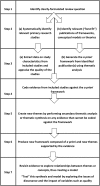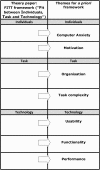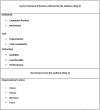How to build up the actionable knowledge base: the role of 'best fit' framework synthesis for studies of improvement in healthcare
- PMID: 26306609
- PMCID: PMC4680127
- DOI: 10.1136/bmjqs-2014-003642
How to build up the actionable knowledge base: the role of 'best fit' framework synthesis for studies of improvement in healthcare
Abstract
Increasing recognition of the role and value of theory in improvement work in healthcare offers the prospect of capitalising upon, and consolidating, actionable lessons from synthesis of improvement projects and initiatives. We propose that informed use of theory can (i) provide a mechanism by which to collect and organise data from a body of improvement work, (ii) offer a framework for analysis and identification of lessons learnt and (iii) facilitate an evaluation of the feasibility, effectiveness and acceptability of improvement programmes. Improvement practitioners can benefit from using an underpinning external structure as a lens by which to examine the specific achievements of their own projects alongside comparable initiatives led by others. We demonstrate the utility of a method known as 'best fit framework synthesis' (BFFS) in offering a ubiquitous and versatile means by which to collect, analyse and evaluate improvement work in healthcare. First reported in 2011, BFFS represents a pragmatic, flexible approach to integrating theory with findings from practice. A deductive phase, where a review team seeks to accommodate a substantial part of the data, is followed by an inductive phase, in which the team explores data not accommodated by the framework. We explore the potential for BFFS within improvement work by drawing upon the evidence synthesis methodology literature and practical examples of improvement work reported in BMJ Quality and Safety (2011-2015). We suggest four variants of BFFS that may have particular value in synthesising a body of improvement work. We conclude that BFFS, alongside other approaches that seek to optimise the contribution of theory to improvement work, represents one important enabling mechanism by which to establish the rigour and scientific credentials of the emerging discipline of 'improvement science'.
Keywords: Evaluation methodology; Health services research; Implementation science; Qualitative research.
Published by the BMJ Publishing Group Limited. For permission to use (where not already granted under a licence) please go to http://group.bmj.com/group/rights-licensing/permissions.
Figures




References
-
- Denyer D, Tranfield D. Using qualitative research synthesis to build an actionable knowledge base. Manag Decis 2006;44:213–27. 10.1108/00251740610650201 - DOI
MeSH terms
LinkOut - more resources
Full Text Sources
Other Literature Sources
